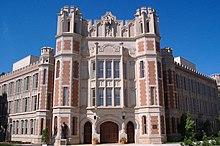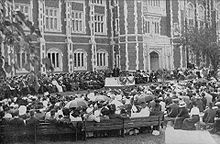User:Smb1138/Sandbox
History
[edit]In 1889, Governor of Oklahoma Territory George Washington Steele urged the Oklahoma Territorial legislature to "create public school systems and universities of higher education". In December 1890, the Legislature established three universities: the state university in Norman, the agricultural and mechanical college in Stillwater (later renamed Oklahoma State University) and a normal school in Edmond (later renamed University of Central Oklahoma).[1] Oklahoma's admission into the union in 1907 led to the renaming of the Norman Territorial University as the University of Oklahoma. Norman residents donated 407 acres (1.6 km2) of land for the university 0.5 miles (0.8 km) south of the Norman railroad depot. The university's first president ordered the planting of numerous trees before the construction of the first campus building because he "could not visualize a treeless university seat."[2] Landscaping remains important to the university.[3]
The university's first president, David Ross Boyd, arrived in Norman in August 1892 and the first students enrolled that year. The School of Pharmacy was founded in 1893 because of high demand for pharmacists in the territory. Three years later, the university awarded its first degree to a pharmaceutical chemist.[4] The "Rock Building" in downtown Norman held the initial classes until the university's first building opened on September 6, 1893.[5]

On January 6, 1903, the university's only building burned down and destroyed many records of the early university. Construction began immediately on a new building as several other towns hoped to capitalize by convincing the university to move. President Boyd and the faculty were not dismayed by the loss. Mathematics professor Frederick Elder said, "What do you need to keep classes going? Two yards of blackboard and a box of chalk."[6] As a response to the fire, English professor Vernon Louis Parrington created a plan for the future development of the campus. Most of the plan was never implemented, but Parrington's suggestion for the campus core formed the basis for the North Oval. The North and South Ovals are now distinctive features of the campus.
Another distinctive feature of campus is the style of architecture. The campus buildings are designed in a unique style, Cherokee Gothic. The style has many features of the Gothic era but has also mixed the designs of local Native American tribes from Oklahoma. This term was coined by the renowned American architect Frank Lloyd Wright when he visited the campus.[7] The University has built over a dozen buildings in the Cherokee Gothic style.
| School Presidents |
| David Ross Boyd, 1892-1908 |
| A. Grant Evans, 1908-1912 |
| Stratton D. Brooks, 1912-1923 |
| James S. Buchanan, 1923-1925 |
| William Bennett Bizzell, 1925-1941 |
| Joseph A. Brandt, 1941-1943 |
| George Lynn Cross, 1943-1968 |
| John Herbert Hollomon, 1968-1970 |
| Paul F. Sharp, 1971-1977 |
| William S. Banowsky, 1978-1984 |
| Frank E. Horton 1985-1988 |
| Richard L. Van Horn, 1989-1994 |
| David Boren, 1994–present |
In 1907, Oklahoma entered statehood, fostering changes in the political atmosphere of the state. Up until this point, Oklahoma's Republican tendencies changed with the election of Oklahoma's first governor, the Democratic Charles N. Haskell. Since the inception of the university, different groups on campus were divided by religion. Early in the university's existence, many professors were Presbyterian, as was Boyd. Under pressure, Boyd eventually hired several Baptists and Southern Methodists.[8] The Presbyterians and Baptists got along but the Southern Methodists conflicted with the administration. Two notable Methodists, Rev. Nathaniel Lee Linebaugh and Professor Ernest Taylor Bynum, were critics of Boyd and activists in Haskell's election campaign. When Haskell took office, he fired many of the Republicans at the university, including President Boyd.[9]
The campus expanded over the next several decades. By 1926, the university encompassed 167 acres (0.7 km2). Development of South Oval allowed for the southern expansion of the campus. The University built a new library on the oval's north end in 1929. Then President Bizzell was able to get the Oklahoma legislature to approve $500,000 for the new library up from their original offer of $200,000.[5]

Like many universities, OU had a drop in enrollment during World War II. Enrollment in 1945 dropped to 3,769, from its Pre-World War II high of 6,935 in 1939.[10]
Many infrastructure changes have occurred at the university. The southern portion of south campus in the vicinity of Constitution Avenue, still known to long-time Norman residents as 'South Base', was originally built as an annex to Naval Air Station Norman. It contained mostly single-story frame buildings used for classrooms and military housing.[11] By the late 1980s, most were severely deteriorated and were demolished in the 1990s to make room for redevelopment. The Jimmie Austin University of Oklahoma Golf Course was built as a U.S. Navy recreational facility.[11]
The north campus and airfield were built in the early 1940s as Naval Air Station Norman. The station served mainly an advanced flight training mission and could handle all but the largest bombers.[12] A large earthen mound east of Interstate 35 and north of Robinson Street, colloquially known as 'Mount Williams',[13] was used as a gunnery (the mound has since been removed to make way for a commercial development).[14] In the post-World War II demobilization, the university received the installation. Naval aviator's wings displayed at the entrance to the terminal commemorates this airfield's Naval past.
After the war, enrollment surged. By 1965, enrollment had risen over 450% to 17,268, causing housing shortages.[10] In the mid 1960s, the administration completed construction of three new 12-story dormitories located immediately south of the South Oval. In addition to these three towers, an apartment complex was completed that housed married students, including men returning to college under the GI Bill.[15] These apartments are now Kraettli Apartments.

In 1943 George Lynn Cross took over as president of the University, two years after the U.S. entered World War II. He served until 1968, 25 years later, becoming the longest-serving president in history of the university. Five presidents served in the next 25 years. In 1994, the university hired a president who has stayed longer.
The university had policies of racial discrimination and segregation which were challenged and overturned in court cases. The Bizzell Memorial Library has been designated a U.S. National Historic Landmark in commemoration of the cases of David McLaurin, a black man who was denied admission to graduate school in 1948. It was then state law that no school should serve both white and black students, but there were few or no separate graduate programs available for blacks. A court case effectively forced the Board of Regents to vote to admit McLaurin, but he was directed to study in a separated area within the law library and to be allowed to lunch only in a segregated area as well. The National Association for Advancement of Colored People brought the case to the U.S. Supreme court in McLaurin vs. Oklahoma State Board of Regents. In 1950, the court overturned the university's policy for segregation at the graduate school level. The case was an important precedent for the more famous and sweeping 1954 case of Brown v. Board of Education which disallowed "separate but equal" policy at all school levels.[16]
Since David Boren became Oklahoma's president in 1994, the University of Oklahoma system has had an increase in new developments throughout including: the purchase of 60 acres (0.2 km2) for OU-Tulsa, the new Gaylord Hall, Price Hall, the ExxonMobil Lawrence G. Rawl Engineering Practice Facility (under construction), Devon Energy Hall (under construction), the Wagner Student Academic Services Center, the Research and Medical Clinic, the expansions of the Fred Jones Jr. Museum of Art,[17] and the National Weather Center.[18]
Sooner Magazine (September 1965)
[edit]- With Optimism for the Morrow
- The Boyd Years
- The Evans Years
- The Brooks Years
- The Buchanan Years
- The Bizzell Years
- The Brandt Years
- The Cross Years
- ^ Levy, David (2005). The University of Oklahoma: A History. Volume I, 1890-1917. Norman, Oklahoma: University of Oklahoma Press. p. 14. ISBN 0-8061-3703-7.
- ^ Gumprecht, Blake (January 2007). "The Campus as a Public Space in the American College Town". Journal of Historical Geography. 33 (1): 72–103. doi:10.1016/j.jhg.2005.12.001. ISSN 0305-7488. Retrieved 2007-05-16.
{{cite journal}}: CS1 maint: date and year (link) - ^ Gillham, Omer (Summer 1997). "Did David Ross Boyd Plant that Tree?" (PDF). Sooner Magazine. LCCN 46043016. Retrieved 2007-05-16.
- ^ "Chronological History. 1890-present". 2006 OU Factbook. University of Oklahoma. Retrieved 2006-06-05.
- ^ a b Long, Charles F. (September 1965). "With Optimism For the Morrow: A History of The University of Oklahoma" (PDF). Sooner Magazine. LCCN 46043016. Retrieved 2006-06-23.
- ^ Levy, David (1975). The University of Oklahoma: A History. Volume I, 1890-1917. Norman, University of Oklahoma Press [1975]. p. 121. ISBN 0806112417.
- ^ http://www.ou.edu/discover/discover_home/virtual_tour/evans_hall.html
- ^ Levy, David W. (Spring 1996). "Combating the Image of "Godlessness" in 1909" (PDF). Sooner Magazine. pp. 28–30. Retrieved 2006-07-03.
{{cite news}}: Cite has empty unknown parameter:|coauthors=(help) - ^ Levy, David (1975). The University of Oklahoma: A History. Volume I, 1890-1917. Norman, University of Oklahoma Press [1975]. pp. 165–66, 172–173. ISBN 0806112417.
- ^ a b "Total Headcount Enrollment, 1892 to Present". 2006 OU Factbook. University of Oklahoma. Retrieved 2006-06-06.
- ^ a b "A University Moves South" (PDF). Sooner Magazine. January 1961. LCCN 46043016. Retrieved 2007-01-22.
{{cite news}}: CS1 maint: date and year (link) - ^ Floren, Sigfrid (December 1941). "O.U.'s Quarter-Million Airport". Sooner Magazine. LCCN 46043016.
{{cite news}}: CS1 maint: date and year (link) - ^ "Beloved lump Mount Williams will be coming down soon". Norman Transcript. August 2003. Retrieved 2008-08-01.
{{cite news}}: CS1 maint: date and year (link) - ^ Scheffer , David J. (March 1998). The clear and present danger of war crimes (Speech). Norman, Oklahoma. Retrieved 2007-01-15.
- ^ Burr, Carol J. (October 1963). Always Room for One More. Sooner Magazine.
{{cite book}}: CS1 maint: date and year (link) - ^ Susan Cianci Salvatore (September 1, 2001) National Historic Landmark Nomination: Bizzell Library, University of Oklahoma, National Park Service and Accompanying 4 photos, exterior and interior, undated.
- ^ For a complete list of campus improvements from 1994-2002, refer here
- ^ "About OKFIRST". University of Oklahoma Board of Regents. Retrieved 2007-01-08.
